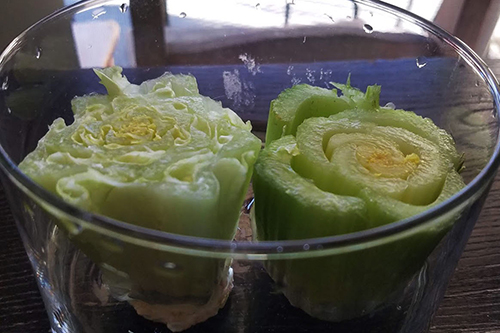 The growing season is winding down, and we are putting our gardens to bed. However, growing your own food doesn’t have to be over. There are many kitchen scraps from your fridge that you can regrow to have freshly grown produce in your own home, including and not limited to romaine lettuce, cabbage, bok choy, celery, carrot greens, turnips, radishes, beets and many herbs.
The growing season is winding down, and we are putting our gardens to bed. However, growing your own food doesn’t have to be over. There are many kitchen scraps from your fridge that you can regrow to have freshly grown produce in your own home, including and not limited to romaine lettuce, cabbage, bok choy, celery, carrot greens, turnips, radishes, beets and many herbs.
For head-form, leafy vegetables like romaine lettuce, cabbage, bok choy and celery, you can regrow them from the base or bottom of the stalk where the roots would normally be. Cut off any leaves or stalks to about 1 inch. Place the base in a shallow bowl with just enough water to cover the base, about a half-inch. It may be helpful to push a few toothpicks into the bottom to provide stability. Replace the water every few days and keep it indoors with full sun. This is best done in a south facing window during the winter season.
You should see new leaves or stalks sprout up from the center. Bok Choy should show new growth within one to two days, and celery and cabbage take about three to four days. Once roots start to form at the base of the plant, you can plant it in a creative container filled with soilless potting mix. Plant the base so that the soil just covers the roots and base, but the top is exposed.
Other plants that can be grown like this are carrot greens, turnips, radishes and beets. Carrot greens are grown by slicing off the top of a carrot where the leaves used to grow. You will not get a new carrot; instead, you will get the carrots greens, which can be added to salads giving a bitter taste. Or, they can be used to create beautiful houseplants with lacey foliage.
For romaine lettuce, be sure to harvest the smaller leaves to get the best flavor. You will not get a whole new head of lettuce from this kitchen scrap, but you will get smaller leaves to add to salads or sandwiches. After the lettuce starts to become spindly and blueish in color, throw it away because it won’t taste very good.
Most herbs can be regrown from cuttings, including basil, mint, cilantro, thyme, parsley, lemon balm, oregano and sage. With the holidays coming up, you can regrow your favorite herbs for adding to traditional food dishes to spice up the flavor. Herbs can be regrown by taking 2- to 3-inch cuttings, including the stem and a few leaves, and placing in a glass with 1 to 2 inches of water. Replace the water regularly, and keep the glass in a location that receives full sun. In about a week, you should see roots beginning to form. Replant the cutting in a container with soilless potting mix. Keep the substrate moist and in full sun for best results.
Regrowing kitchen scraps can be a fun experiment for children to learn about growing plants and their own food. It is also a great way to bring some green into the home after the tree leaves have fallen and the outdoors assumes its winter gloom.
Fisher, J.
2018,
Bring vegetable growing indoors this winter,
Reno Gazette Journal


